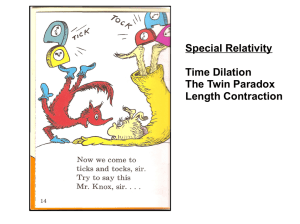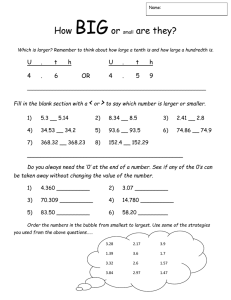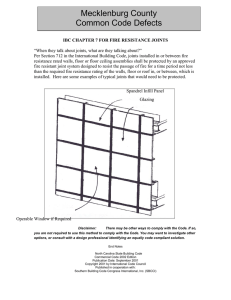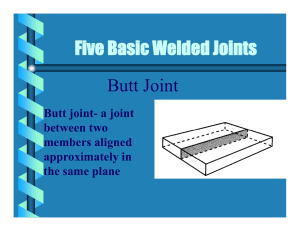Testing leaktightness of welded joints using a bubble test with a
advertisement
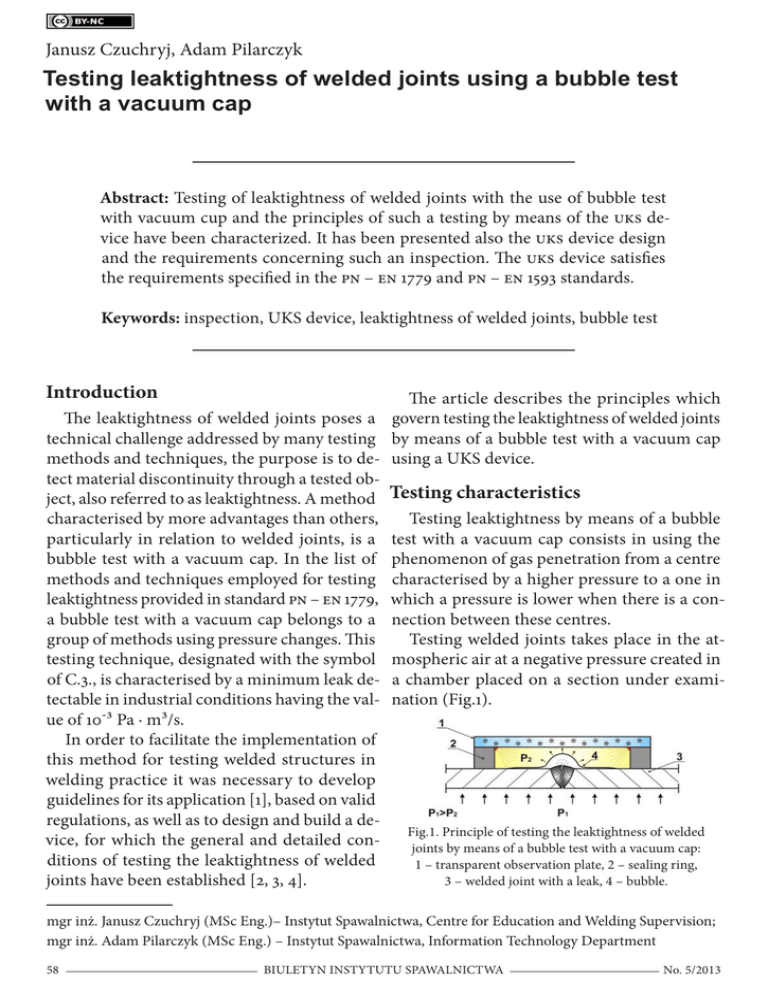
Janusz Czuchryj, Adam Pilarczyk Testing leaktightness of welded joints using a bubble test with a vacuum cap Abstract: Testing of leaktightness of welded joints with the use of bubble test with vacuum cup and the principles of such a testing by means of the UKS device have been characterized. It has been presented also the UKS device design and the requirements concerning such an inspection. The UKS device satisfies the requirements specified in the PN – EN 1779 and PN – EN 1593 standards. Keywords: inspection, UKS device, leaktightness of welded joints, bubble test Introduction The article describes the principles which The leaktightness of welded joints poses a govern testing the leaktightness of welded joints technical challenge addressed by many testing by means of a bubble test with a vacuum cap methods and techniques, the purpose is to de- using a UKS device. tect material discontinuity through a tested object, also referred to as leaktightness. A method Testing characteristics characterised by more advantages than others, Testing leaktightness by means of a bubble particularly in relation to welded joints, is a test with a vacuum cap consists in using the bubble test with a vacuum cap. In the list of phenomenon of gas penetration from a centre methods and techniques employed for testing characterised by a higher pressure to a one in leaktightness provided in standard PN – EN 1779, which a pressure is lower when there is a cona bubble test with a vacuum cap belongs to a nection between these centres. group of methods using pressure changes. This Testing welded joints takes place in the attesting technique, designated with the symbol mospheric air at a negative pressure created in of C.3., is characterised by a minimum leak de- a chamber placed on a section under examitectable in industrial conditions having the val- nation (Fig.1). ue of 10-3 Pa ∙ m3/s. In order to facilitate the implementation of this method for testing welded structures in welding practice it was necessary to develop guidelines for its application [1], based on valid regulations, as well as to design and build a deFig.1. Principle of testing the leaktightness of welded vice, for which the general and detailed conjoints by means of a bubble test with a vacuum cap: ditions of testing the leaktightness of welded 1 – transparent observation plate, 2 – sealing ring, joints have been established [2, 3, 4]. 3 – welded joint with a leak, 4 – bubble. mgr inż. Janusz Czuchryj (MSc Eng.)– Instytut Spawalnictwa, Centre for Education and Welding Supervision; mgr inż. Adam Pilarczyk (MSc Eng.) – Instytut Spawalnictwa, Information Technology Department 58 BIULETYN INSTYTUTU SPAWALNICTWA No. 5/2013 Leaks in a joint constitute connections between centres of various pressures. In a joint covered with a foam-producing solution (liquid detector) air enters the chamber from the atmosphere through leaks due to a pressure difference. As a result, a bubble enabling the detection and location of a leak is formed. The described method of testing leaktightness can be used in relation to such products as non-pressure tanks for gases and liquids, silos, tankers on independent chassis, non-pressure pipelines and systems, container bottoms, covers, parts of various types of jackets, segment knees, containers, flat objects of ships, etc. The methods are not used for testing the leaktightness of pressure equipment. A bubble method with vacuum cap does not replace a pressure leaktightness test or a structural strength test. a bubble test with a vacuum cap are listed in Table 1 [1]. As can be seen in Table 1, a bubble test with a vacuum cap can be an alternative to leaktightness tests with such methods as compressed air, chalk and kerosene, penetrant or gaseous ammonia and phenolphthalein. UKS device for testing leaktightness of welded joints A device for testing the leaktightness (UKS) of welded joints using a bubble test with a vacuum cap, designed and built at Instytut Spawalnictwa, is presented in Figure 2. A device consists of two basic components, i.e.: a vacuum cap (exchangeable vacuum chambers) and a suction pump. The vacuum chamber limits the space in which a negative working pressure is generated. The chamber consists Advantages and disadvantages of of a transparent observation plate and a seal bubble test (usually a rubber or plastic one). The transparThe advantages and disadvantages of leak- ent plate enables the observation of a joint sectightness tests of welded joints by means of tion during testing. The seal, tightly adhering Table 1. Advantages and disadvantages of bubble test with vacuum cap in comparison with other leaktightness testing methods. comparative criteria Method sensitivity bubble test with vacuum cap - leaktightness testing method with compressed air With with amchalk with monia and by with soap and penetrant phenolby blowing immersion in solution kerosene phthalein water lower lower Access to joint from one side from both sides from one side (necessity of manoeuvring with the structure) Type of test rig portable stationary stationary lower lower higher from one side from both sides from both sides from one side stationary - - portable lower lower lower - - gas supply system approximately 30 m/h Testing rate lower lower lower (chamber 1 m in length) necessity of possessing compressed compressed compressed Additional a chamber air system or air system or air system or requirements adjusted to compressor compressor compressor a joint shape No. 5/2013 BIULETYN INSTYTUTU SPAWALNICTWA 59 to the base, isolates a chamber volume from the environment. The observation plate of each chamber has been provided with a connector to a flexible duct and a vent valve. The suction pump generates a required negative pressure in the chamber by pumping air out of the chamber through the flexible duct connecting the connector with the pump. The valve enables the aeration of the chamber after a test as well as the adjustment of a pressure in the Fig. 2. Device for testing the leaktightness of welded joints using a bubble test chamber by appropriate setting with a vacuum cap: schematic diagram: 1 – suction pump, 2 – oblong chamber, 3 – round chamber, 4 – angular chamber, 5 – observation plate, 6 – seal. with adjustment knobs. In order to provide appropriate observation conditions of bubbles, the chambers The oblong chambers are intended for testing have been equipped with diode lighting of ad- flat butt joints. In turn, the round chamber is justable intensity. Such a solution enables test- used for testing butt cruciform joints and joints ing to be carried out in any operator’s work on curved surfaces (e.g. spherical ones) (Fig.3). environment lighting conditions. The current Testing flat joints with the round chamber version of the device features oblong chambers is also possible, yet a testable section is only 21 of three testing lengths (92 cm, 75 cm and 50 cm in length. As can be seen the round chamcm) and a round chamber with an internal di- ber is characterised by a significant versatility. ameter of 21 cm. The chambers weigh approx- However, during testing flat joints the oblong imately 12 kg, 10 kg, 7 kg and 3 kg respectively. chambers are characterised by a considerably greater efficiency. Both a) b) the oblong and the round chamber enable testing the leaktightness of fillet welds in overlap joints, where the thickness of the base metal of an overlap should not exceed 20–12 mm. c) d) General requirements for leaktightness test Personnel qualifications Fig.3. Testing the leaktightness of welded joints using: a) oblong chamber, b) round chamber, c) container for liquid fuels, d) cruciform joint. 60 BIULETYN INSTYTUTU SPAWALNICTWA Testing the leaktightness of welded joints using a bubble test with a vacuum cap should be carried out by personnel No. 5/2013 and also gently pass to the base metal. No special requirements have been established in relation to plug welds. Gentle passing of welds to the base metal facilitates the adhesion of the seal of the vacuum cap to a joint and prolong the life of the former. A weld to be tested for leaktightness and at least 40 mm wide zones adjacent to the weld (on both sides) should be thoroughly cleaned. All slag, rust, paint, lubricants, scale and weld deposit spatters must be removed. Indicator Note: impurities left on the surface of joints It is recommended that in a bubble test with may screen forming bubbles or cause false a vacuum cap, the air or an inert gas (e.g. nitro- indications. gen) should be used as the indicator (detector) of leaks. However, in the latter case one should Detecting liquids take into account an operator’s safety factors reLeaktightness tests by means of a bubble test lated to the possibility of oxygen deficit in the with a vacuum cap should involve surface-acatmosphere surrounding a test rig. tive liquids (foam-producing solutions). Such leak-detecting liquids should be non-volatile, Surface temperature i.e. they should not dry up at the testing temperThe temperature of a surface to be tested for ature. They should also be viscous and not foam its leaktightness should be between +10°C and at a generated negative pressure. Commercially +50°C. Temperatures lower than recommend- available liquids not intended for leaktightness ed are also acceptable on condition that they tests should not be used, unless their usabiliare not lower than +5°C due to the possibility ty has been previously demonstrated (e.g. by of steam condensation on surfaces to be tested a type test or through a comparison with the and in leaks to be detected. Such a situation may properties of an approved liquid). In the case prevent the formation of a bubble demonstrat- of detected gas leaks bubbles should maintain ing the existence of a leak. In order to maintain their shape during the duration of a test. While a temperature within the range specified above testing vertical surfaces the viscosity of a detectit is allowed to locally heat or cool an area un- ing liquid can be enhanced, if need be, by using der investigation. approved methods. A detecting liquid should If observing surface temperature restrictions demonstrate the conformity with the structuris technically or economically problematic, other al materials of objects (products) tested. A contaminated detecting liquid or a liquid temperature values, specified in a related instruction (procedure) as appropriate, can also be used. undergoing spontaneous foaming during testing may cause false indications and for this reaRequirements for welded joints son the use of such liquids should be forbidden. The height of the reinforcement and the roots of butt welds in joints tested for leaktightness Testing conditions and procedure using a bubble tests with a vacuum cup should The conditions for the leaktightness tests of be in conformity with use-related standards and welded joints using a UKS device have been specgently pass to the base metal (welded). The face ified for a foam-producing solution composed of fillet welds should be flat or slightly concave of water, soap and glycerine in the following having sufficient knowledge and skills. For this reason it is recommended that personnel should be certified in accordance with the requirements of standard PN – EN ISO 9712 or an equivalent. Testing the leaktightness of welded joints can be also conducted by uncertified personnel, yet they should have undergone training in the testing method and the operation of the testing device confirmed with an appropriate certificate. No. 5/2013 BIULETYN INSTYTUTU SPAWALNICTWA 61 proportion: water – 1 litre, toilet soap 0.50 g, glycerine – 5 g. The testing conditions are the applied difference of pressures and the time at which it is maintained, the temperature of the detecting liquid (foam-producing solution) as well as the intensity of lighting of the surface being tested. • Difference between the atmospheric air pressure and the pressure of the air in the vacuum chamber (negative pressure value) cannot be lower than 50 kPa. • Pressure difference maintenance time should be at least 30 seconds. • Temperature of a detecting liquid should be not lower than +20°C. • Intensity of lighting of a welded joint surface being tested should be at least 500 lx. A surface-active detecting liquid should be applied on the surface of a welded joint with a soft brush, by spraying or using other methods. A leaktightness test of a joint with a UKS device consists in placing a vacuum chamber (vacuum cap) on a section tested, pressing the cap against the surface, pumping the air out and observing whether bubbles are formed (Fig.4). The formation of bubbles indicates discontinuities through a joint, which also implies the presence of leaks. Afterwards, the chamber is aerated and placed on another section of a joint and the actions described above are repeated. The formation of bubbles is observed with the naked eye from approximately 10 cm (near point) to a maximum of 60 cm (measured in relation to a surface being measured) and at an angle between 30o and 90o. In order to improve the angle of view it is allowed to use auxiliary measures such as mirrors, magnifying glasses, telescopes, endoscopes, grain flow patterns or other appropriate devices. It is recommended that the resolution of such devices should be at least equivalent to the resolution obtained during testing with a naked eye. If necessary, the results of leaktightness tests of welded joints using a bubble test with a vacuum cup should be presented in a test report. A report should contain at least the identifier of an object and the joint being tested, the type of detecting liquid used, the difference of pressures (negative pressure) applied, the time for which the difference of pressures was maintained, the temperature of the detecting liquid, the temperature of the surface examined, the intensity of the lighting of the surface examined, the description of the manner of designating places containing leaks (test results), the operator’s name and surname, the date of the test and the operator’s certificate. 1. 2. 3. 4. 5. 6. Fig.4. Bubbles indicating the presence of leaks on the surface of a welded joint. Sequence frequency: 6 seconds. 62 BIULETYN INSTYTUTU SPAWALNICTWA No. 5/2013 Summary that the nearest future will see the extension of The development and building of a UKS de- the product range with new solutions and apvice partly filled the gap in monitoring the leak- plications of vacuum chambers. tightness of welded joints using a bubble test with a vacuum cap. It has enabled a wider use References: of a bubble test in industrial practice, particu- 1. Czuchryj, J. Kontrola szczelności złączy spawanych za pomocą próby pęcherzykowej z larly in relation to products, whose basic operation approval condition is the leaktightness przyssawką próżniową. Wytyczne Instytutu of welded joints. The device is characterised by Spawalnictwa nr W – 12/IS – 57. the simplicity of structural solutions used and 2. Czuchryj, J. (1982). Urządzenie do kontroli the fulfilment of the requirements referred to szczelności złączy spawanych metodą próżin standards PN – EN 1779 and PN – EN 1593. An niową. Prace Instytutu Spawalnictwa, (4). unquestionable advantage of the device is its 3. Czuchryj, J. (1984). Urządzenie do kontroli szczelności metodą próżniową połączeń easy operation and the environmental friendspawanych. Przegląd Spawalnictwa, (1). liness of testing substances. The design of the UKS device has been recog- 4. Czuchryj, J. (1993). Urządzenie UKS-2 do nised by the Polish Patent Office. In decision no. kontroli szczelności złączy spawanych meDT/Wp.20509/6/EDO of 12.03.2013 Instytut Spatodą podciśnieniową. Biuletyn Instytutu walnictwa in Gliwice was granted an industriSpawalnictwa, (4). al design right entitled “Device for monitoring 5. Czuchryj, J. (1999). Wykorzystanie metothe leaktightness of welded joints using a bubdy podciśnieniowej do kontroli szczelności ble test with a vacuum chamber”. złączy spawanych. Biuletyn Instytutu SpaThe UKS device underwent an assessment at walnictwa, (6). an invention fair held in Paris this year as well 6. Czuchryj, J. and Bartosz, Ł. (2006) Zastoas at Poznań International Fair held in June this sowanie próby pęcherzykowej do badania szczelności złączy spawanych. Biuletyn Inyear. As a result, in both cases the device was stytutu Spawalnictwa, (3). distinguished with gold medals and related di7. Szymański, A. (1998). Kontrola i zapewnieplomas (Fig.5 and 6). nie jakości w spawalnictwie. vol. 2. WydawThe UKS device has proved a commercial sucnictwo Politechniki Śląskiej. Gliwice. cess finding applications in everyday industrial practice. It should be mentioned that the de- 8. Hlebowicz, J. (1996). Badanie szczelności. Poradvice is continuously modernised. It is expected nik. Wydawnictwo „Biuro Gamma”. Warszawa. Fig.5. Medal and a related diploma obtained at an invention fair in Paris No. 5/2013 Fig.6. Medal and a related diploma obtained at Poznań International Fair BIULETYN INSTYTUTU SPAWALNICTWA 63 9. Hlebowicz, J. (2001). Badania nieniszczą- Reference standards: ce. Badanie szczelności urządzeń i instala- –– PN – EN 1330 – 8 ”Non-destructive testing – Terminology – Terms used in leak tightness cji technicznych. Poradnik. Wydawnictwo testing”. „Biuro Gamma”. Warszawa. –– PN – EN 1593 ”Non-destructive testing – Leak testing – Bubble emission techniques”. –– PN – EN 1779 ”Non-destructive testing – Leak testing – Criteria for method and technique selection”. –– PN – EN ISO 9712 ”Non-destructive testing– Qualification and certification of NDT personnel”. 64 BIULETYN INSTYTUTU SPAWALNICTWA No. 5/2013
